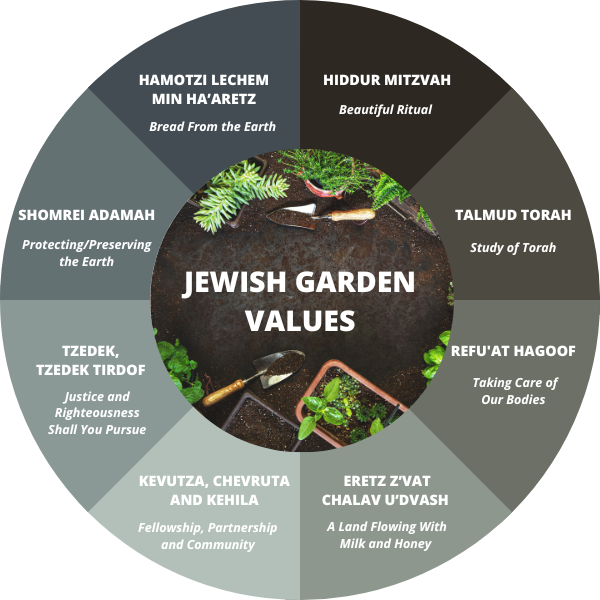JEWISH GARDEN VALUES
Values for a Jewish Gardener and Values in a Jewish Garden
A listing of Jewish values that can be illustrated in a garden space and the Jewish values of caring for the earth that we can live out as we care for our garden.

SHOMREI ADAMAH: Protecting/Preserving the Earth
In the beginning of Genesis, Adam and Eve are instructed to till and tend, to have stewardship and dominion over the land. Adam’s name originates from Adama, meaning from the Earth, and embodies our connection to the soil. Throughout the garden, there are opportunities to teach aspects of conservation and sustainability. From water barrels to composting, we try to be sensitive to natural resources and consumption. As we work the soil, we are keenly aware of the responsibility of humanity for the Earth. We can find ways to bring the stories of creation and caring for the Earth into our garden.
HIDDUR MITZVAH: Beautiful Ritual
According to Jewish tradition, we should not just complete the ritual, even with the best of intentions. Instead, we should try to make it beautiful, rich with color and texture. This is the reasoning behind the adorned candlesticks for Shabbat and the beautiful melodies for our prayers. We want our rituals to be mouthwatering and eye catching, resonating with all of our sensory experiences so that our souls can soar. When we incorporate garden beauty, recycled creativity, and the personal effort of using the garden for ritual, we add to this value of Hiddur Mitzvah.
TZEDEK, TZEDEK TIRDOF: Justice and Righteousness Shall You Pursue
Jewish sages caution us to pay attention to the repetition of a word in Torah. In our gardens we aspire to bring Tzedek – justice and righteousness – from two directions: receiving and giving. With humility and appreciation for what we harvest, we can share some of our bounty. We can also look out and see that there are people in need of sustenance in our own community. With an effort from our garden, we can help feed the hungry.
TALMUD TORAH: Study of Torah
Throughout a Jewish garden there can be plants and spaces that illustrate and ground stories, values, characters, and concepts of Torah and Hebrew literature. In one congregation, the week after threshing and winnowing a handful of wheat harvested from the synagogue garden, a Bat Mitzvah student encountered this passage in her Haftarah:
15 I will make of you a threshing board, A new thresher, with many spikes; You shall thresh mountains to dust, And make hills like chaff. 16 You shall winnow them, and the wind shall carry them off; The whirlwind shall scatter them. But you shall rejoice in the ETERNAL, And glory in the Holy One of Israel. Isaiah 41:15- 16
The hands-on experience with the wheat gave her an important illustration for comprehending the passage she was working on. This constantly happens because the text of Torah and the Hebrew Bible are set in an agricultural world. By going into the garden and experiencing these actions we are more attuned to the rhythms, tools, and actions that are used to describe God’s interactions with the earth and with us.
KEVUTZA, CHEVRUTA, AND KEHILAH: Fellowship, Partnership and Community
Maintaining a garden takes a village. With a collective effort from the beginning, individuals can experience the fulfillment of community. Similar to the pioneers from the early days of an Israeli Kibbutz, a garden can teach the community the necessity of collaboration.
REFU’AT HAGOO: Taking Care of Our Bodies
ERETZ Z’VAT CHALAV U’DVASH: A Land Flowing With Milk and Honey
HAMOTZI LECHEM MIN HA’ARETZ: Bread From the Earth

Donate
Directions